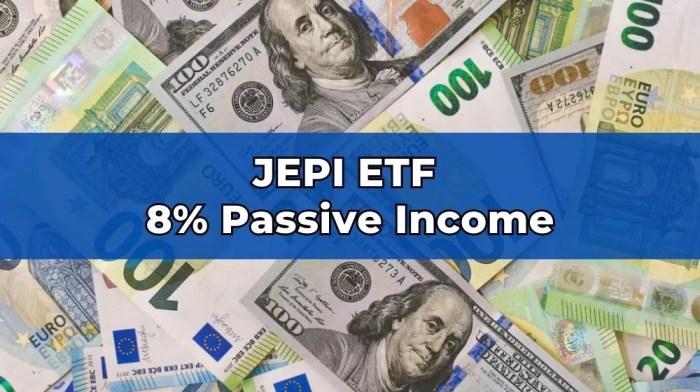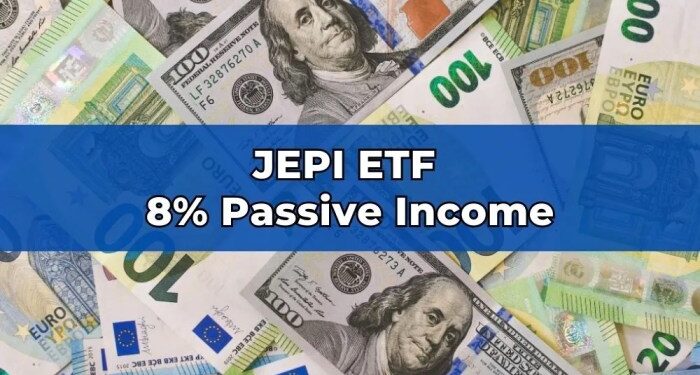Delving into JEPI ETF: Is This the Right Time to Buy?, this introduction immerses readers in a unique and compelling narrative, with engaging language that is both informative and captivating.
Exploring the history, features, and benefits of JEPI ETF sets the stage for understanding its potential in the market.
Overview of JEPI ETF
JEPI ETF, or the JPMorgan Equity Premium Income ETF, is an exchange-traded fund that focuses on providing investors with exposure to the equity risk premium. This ETF aims to generate income through a combination of equity exposure and options strategies.
History and Background
The JEPI ETF was launched by JPMorgan in 2020 and is designed to provide investors with a unique way to access the equity market while also generating income. The fund is managed by a team of experienced professionals who utilize a rules-based approach to implement options strategies.
Key Features and Benefits
- Combination of Equity Exposure and Options Strategies: JEPI ETF offers investors the opportunity to gain exposure to equities while also benefiting from options strategies designed to enhance income potential.
- Income Generation: One of the primary goals of JEPI ETF is to generate income for investors through a combination of dividends, interest, and options premiums.
- Risk Management: The fund aims to manage risk by utilizing options strategies to help protect against market downturns and limit potential losses.
- Diversification: JEPI ETF provides investors with diversified exposure to a wide range of equities, which can help reduce concentration risk in a portfolio.
Market Performance
When analyzing the recent performance of JEPI ETF in the market, it is essential to consider various factors that have influenced its trajectory. JEPI ETF, like many other exchange-traded funds, is subject to market fluctuations and investor sentiment.
Comparison with Similar ETFs
- One way to gauge JEPI ETF's performance is to compare it with other similar ETFs in the market. By looking at key metrics such as returns, volatility, and expense ratios, investors can assess how JEPI ETF stacks up against its competitors.
- It is crucial to consider the underlying assets, sector exposure, and geographical diversification of JEPI ETF compared to its counterparts to understand its relative performance.
Trends and Patterns
- Identifying trends or patterns in JEPI ETF's market performance can provide valuable insights for investors. Whether it follows market trends closely or exhibits unique patterns can impact investment decisions.
- By analyzing historical data and considering external factors like economic indicators and geopolitical events, investors can better understand the potential future performance of JEPI ETF.
Economic Factors

When it comes to the performance of JEPI ETF, economic factors play a crucial role in shaping its movements in the market. Factors such as interest rates, inflation, and GDP growth can have a significant impact on how the ETF performs.
Interest Rates
Interest rates set by central banks can directly influence the performance of JEPI ETF. When interest rates are low, investors may be more inclined to invest in ETFs like JEPI, seeking higher returns. Conversely, when interest rates rise, the attractiveness of ETFs may decrease as investors can find better returns elsewhere.
Inflation
Inflation, the rate at which the general level of prices for goods and services rises, can erode the purchasing power of investors. High inflation can negatively impact the performance of JEPI ETF as it reduces the real value of investments over time
On the other hand, low inflation rates can be favorable for ETF performance.
GDP Growth
The GDP growth rate of a country reflects its economic performance. Strong GDP growth can lead to increased corporate profits and overall market optimism, which can benefit JEPI ETF as well. Conversely, sluggish GDP growth or economic contraction can dampen investor confidence and hinder the performance of the ETF.
Overall, economic events such as changes in interest rates, fluctuations in inflation, and shifts in GDP growth have historically influenced the performance of JEPI ETF. Investors should closely monitor these economic factors to make informed decisions about buying or selling the ETF.
Risk Analysis
Investing in JEPI ETF comes with its own set of risks that investors need to consider. It is important to evaluate these risks and compare them with other investment options to make an informed decision. Additionally, identifying strategies to mitigate these risks can help investors navigate the market more effectively.
Risk Factors of JEPI ETF
- Market Risk: JEPI ETF is subject to market fluctuations, which can impact the value of the fund.
- Interest Rate Risk: Changes in interest rates can affect the performance of JEPI ETF, especially for fixed-income securities.
- Liquidity Risk: Limited liquidity in the market can make it difficult to buy or sell JEPI ETF shares at desired prices.
- Currency Risk: For investors holding JEPI ETF in a foreign currency, fluctuations in exchange rates can impact returns.
Comparison with Other Investments
- Compared to individual stocks, JEPI ETF offers diversification benefits that can help mitigate risk.
- When compared to mutual funds, JEPI ETF typically has lower expense ratios, making it a more cost-effective investment option.
- However, compared to bonds, JEPI ETF may carry higher market risk due to exposure to equities.
Mitigation Strategies
- Diversification: Spreading investments across different asset classes can help reduce risk exposure.
- Regular Monitoring: Keeping track of market trends and performance can help investors make timely decisions.
- Setting Stop-Loss Orders: Implementing stop-loss orders can help limit potential losses in case of market downturns.
- Consulting with a Financial Advisor: Seeking advice from a professional can provide valuable insights on managing risks effectively.
Concluding Remarks
In conclusion, JEPI ETF offers a promising investment opportunity, but careful consideration and analysis are essential before making a decision. This discussion has shed light on various aspects to help you navigate this investment landscape effectively.
Questions and Answers
What is JEPI ETF and its primary focus?
JEPI ETF is an exchange-traded fund that focuses on investing in a diverse portfolio of companies. Its primary focus is to provide investors with exposure to a wide range of sectors and industries.
How do economic factors influence JEPI ETF performance?
Economic factors like interest rates, inflation, and GDP growth can impact JEPI ETF performance. For example, rising interest rates may negatively affect stock prices within the ETF.
What are the risks associated with investing in JEPI ETF?
Risks associated with JEPI ETF include market volatility, sector-specific risks, and economic downturns. It's important for investors to assess these risks before investing.



